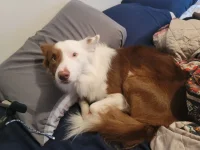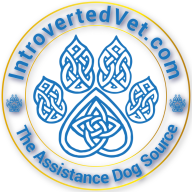by Carlene White
As these pups are now learning about collars and leashes, we need to have a discussion about their function. These are my opinions only — there is no absolute right or wrong.
The standard leather collar is usual; but, in my mind, the chain training collar is a better tool for training.
Number one: they can not back out of it. And if you use it correctly by snatch and release, it does not choke the dog any more than the leather collar. It was given the name "choke collar," but it needs to be renamed "training collar."
Then there are a few variations of the gentle leader, which is not gentle. Dogs hate it. They may get used to it and accept it, but they hate it.
To start our puppies, we take our simple rope with a ring. You make the usual noose around the neck and then continue the leash part found over the body, behind the front legs, and back up through the ring. This makes for a leash that they cannot back out of.
In the movie business, I used that configuration many times to handle many different animals.
You do have to pull on that leash, as you are going to be grabbing the entire puppy and not just the neck.
We use that for a few weeks until we basically have the pups' attention … and we are ready to work in public.
Around the Service Dog Project, we never allow a tight leash. We never allow our muscles to control the dogs because, eventually, you're not going to be able to control by muscle, anyway. If you're talking to the dog and teaching the dog something, it is not going to learn anything if that leash is too tight. You want him to make the choice of doing what you'd like to have him do.
So, by the time we get in public, we have the chain training collar and a 26-inch leash. A dog that is working as a service dog should always be within about six inches from your knee. Having such a short leash is a way of reminding our trainers that you don't let the dogs wander all over.
If the dog should get ahead and pull on the leash, what you need to do is to give it a quick snatch to tighten it … and then immediately release it so you give the dog a chance to think about it and hopefully get back in line right next to your leg.
The immediate-release is the $5 million lesson here.
The rope and a ring — so very many uses. A Scottish tradition. The photo is a horse with the same rope.

 thelocalne.ws
thelocalne.ws
As these pups are now learning about collars and leashes, we need to have a discussion about their function. These are my opinions only — there is no absolute right or wrong.
The standard leather collar is usual; but, in my mind, the chain training collar is a better tool for training.
Number one: they can not back out of it. And if you use it correctly by snatch and release, it does not choke the dog any more than the leather collar. It was given the name "choke collar," but it needs to be renamed "training collar."
Then there are a few variations of the gentle leader, which is not gentle. Dogs hate it. They may get used to it and accept it, but they hate it.
To start our puppies, we take our simple rope with a ring. You make the usual noose around the neck and then continue the leash part found over the body, behind the front legs, and back up through the ring. This makes for a leash that they cannot back out of.
In the movie business, I used that configuration many times to handle many different animals.
You do have to pull on that leash, as you are going to be grabbing the entire puppy and not just the neck.
We use that for a few weeks until we basically have the pups' attention … and we are ready to work in public.
Around the Service Dog Project, we never allow a tight leash. We never allow our muscles to control the dogs because, eventually, you're not going to be able to control by muscle, anyway. If you're talking to the dog and teaching the dog something, it is not going to learn anything if that leash is too tight. You want him to make the choice of doing what you'd like to have him do.
So, by the time we get in public, we have the chain training collar and a 26-inch leash. A dog that is working as a service dog should always be within about six inches from your knee. Having such a short leash is a way of reminding our trainers that you don't let the dogs wander all over.
If the dog should get ahead and pull on the leash, what you need to do is to give it a quick snatch to tighten it … and then immediately release it so you give the dog a chance to think about it and hopefully get back in line right next to your leg.
The immediate-release is the $5 million lesson here.
The rope and a ring — so very many uses. A Scottish tradition. The photo is a horse with the same rope.

Service Dog Column: To pull or not to pull - North Shore News
Carlene White turns her attention to leashes and how they can be used to train a service dog. They need to stay close to their owners.
 thelocalne.ws
thelocalne.ws











